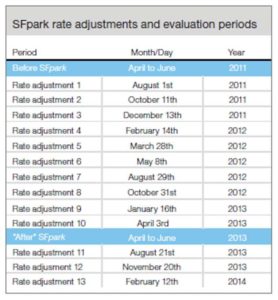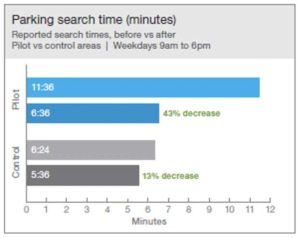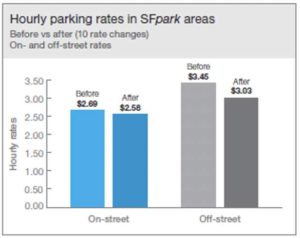 Modern Mobility is a biweekly opinion column. The views expressed are solely the author’s.
Modern Mobility is a biweekly opinion column. The views expressed are solely the author’s.
The Arlington County Board is set to vote this weekend on accepting a grant to implement a performance parking pilot in Arlington’s Metrorail corridors.
Performance Parking is a proven approaching to managing parking supply to make parking more convenient. It uses technology to measure parking demand, and over time matches the price of that parking to demand, ensuring that parking is generally available where people want it, when people want it.
How Does it Work?
When trying to understand how performance parking works, it’s helpful to look at an existing example while keeping in mind that there are many ways to customize a performance parking implementation plan to fit each community. One of the most well-known and well-documented examples is SFPark in San Francisco.
 The SFPark pilot installed in-pavement parking occupancy sensors across 7 parking management areas which included about 25% of the city’s on-street spaces. Approximately every 8 weeks, the city adjusted parking rates for each block based on average parking occupancy of that block, according to the following formula: blocks that saw 80-100% occupancy the rate was increased by $0.25, blocks where the occupancy was 60-80% the rate was left alone, blocks where occupancy was 30-60% the hourly rate was decreased by $0.25, blocks where the occupancy rate was below 30% the hourly rate was decreased by $0.50.
The SFPark pilot installed in-pavement parking occupancy sensors across 7 parking management areas which included about 25% of the city’s on-street spaces. Approximately every 8 weeks, the city adjusted parking rates for each block based on average parking occupancy of that block, according to the following formula: blocks that saw 80-100% occupancy the rate was increased by $0.25, blocks where the occupancy was 60-80% the rate was left alone, blocks where occupancy was 30-60% the hourly rate was decreased by $0.25, blocks where the occupancy rate was below 30% the hourly rate was decreased by $0.50.
These pricing adjustments were made approximately every 8 weeks. Unlike something like Uber’s Surge pricing, these are not sudden, real-time changes – they are slow, deliberate changes made over a period of months with clear, predictable signage. Over time they find the true intersection of the parking supply and demand curves and ensure that parking is available on each block when people need it.
What does it Accomplish?
 SFPark made parking easier to find. The amount of time that blocks achieved the target parking occupancy (60 to 80%) increased by 31% in pilot areas, compared to a 6% increase in control areas. The amount of time that blocks were too full to find parking decreased 16% in pilot areas while increasing 51% in control areas.
SFPark made parking easier to find. The amount of time that blocks achieved the target parking occupancy (60 to 80%) increased by 31% in pilot areas, compared to a 6% increase in control areas. The amount of time that blocks were too full to find parking decreased 16% in pilot areas while increasing 51% in control areas.
SFPark saved people time. In SFpark pilot areas, the amount of time most people reported that it took to find a space decreased by 43%, from about 11 ½ minutes to about 6 ½ minutes.
 SFPark reduced greenhouse gas emissions. Due to reduced time spent circling for a parking space, drivers went from generating about 7 metric tons of ghg emissions per day looking for parking prior to the pilot to about 4.9 metric tons of emissions per day after the pilot.
SFPark reduced greenhouse gas emissions. Due to reduced time spent circling for a parking space, drivers went from generating about 7 metric tons of ghg emissions per day looking for parking prior to the pilot to about 4.9 metric tons of emissions per day after the pilot.
SFPark reduced double parking. Double parking increases dramatically as convenient parking gets harder to find. In SFPark pilot areas, double parking decreased by 22% compared to a 5% decrease in the control areas.
SFPark reduced congestion and improved transit speeds. Due to a reduction in drivers circling for spaces and the reduction in double parking, peak period congestion decreased and transit speed increased in the pilot areas.
SFPark lowered average hourly parking meter rates. Over the course of the SFPark pilot, the average hourly rates at meters dropped from $2.69 to $2.58.
What could make them even better?
While these benefits are compelling, it is also true that the on-street parking would become more expensive on the most in-demand blocks at the most in-demand times of day. To provide additional benefit to these areas, the County should consider instituting Parking Benefits Districts.
The idea of Parking Benefit Districts is to take some portion of the parking fees collected by the County (after accounting for the cost to administer the program) and re-invest them in the neighborhood from which they were collected.
In the South Side Parking Benefits district in Pittsburgh, parking revenues are deposited into a completely separate fund which is used exclusively for public safety and public infrastructure improvements in the neighborhood.
In the Washington Avenue Parking Benefits district in Houston, parking revenues fund projects selected by an advisory committee within the area. Potential projects may include “sidewalk repairs, landscaping, lighting, alternative transportation, marketing for the district or funding for a garage”.
In Arlington, one could easily imagine Parking Benefit Districts funding improved landscaping, lighting, better signage, tree planting, watering and pruning, bike and e-scooter parking, public art, or any number of other investments to improve the beauty, sustainability or quality of life in our neighborhoods.
These benefits would, however, be just the cherry on top of a program that could provide major benefits all on its own – less time searching for parking, fewer cars circling our streets (which could even result in fewer crashes), reduced greenhouse gas emissions and potentially lower overall meter prices. To have such a program’s initial implementation fully funded by a grant from the Commonwealth makes it a true win-win.
Chris Slatt is the current Chair of the Arlington County Transportation Commission, founder of Sustainable Mobility for Arlington County and a former civic association president. He is a software developer, co-owner of Perfect Pointe Dance Studio, and a father of two.

